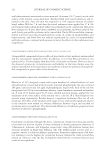INTERPRETATION OF HALAL COSMETICS IN MALAYSIA 147 Besides that, cosmetic products that use synthetic additive or chemicals in excessive amounts or beyond the limitation that are sometimes hazardous are prohibited by a number of coun- tries such as the NPRA of Malaysia, European Union Regulation, and the Food and Drug Administration of the United States because of the health risk it possess (14,19,28). This aspect may also affect the halal status because another important element of halal cosmetic is to use harmless ingredients whether they are active or inactive ingredients. Thus, it is important to discuss and instill ethics in the whole aspect of halal compliance. Remote re- sponsibility can act as a safeguard against misuse, mistreatment, and destruction. All cosmetic products must contain safe ingredients, be manufactured under good manufacturing practice, and undergo an adequate safety assessment to comply with the regulatory requirement and halal and quality control before they are released to the market (16,19). Therefore, the aspect of ingredient for either the source or process, along with the ethics of manufacturer, need to be integrated and elaborated to have a comprehensive understanding of the halal–tayyib relationship and concept. Table III describes the integrated halal cosmetic matrix for halal status determination. DISCUSSION The main critical point for the differences between general and halal cosmetic is the ori- gin of raw materials because it is the key aspect of the fi nal cosmetic product. The origin of ingredients is always a vital aspect among Muslims because of the impact on daily re- ligious activities such as solat (pray). The aspect of purity and cleanliness are important elements highlighted in the Islamic teachings. The other important points for the differ- ences are toyyib characteristics that functioned as the complementing aspect of halal in ensuring the best quality of the product. In regard to the classifi cation of ingredients, the authorities such as the NPRA Ma- laysia and Cosmetic Ingredient Review that have different categories of cosmetic ingredients, namely, safe, prohibited, and allowed with limitations (19), and safe as used, safe with qualifi cation, unsafe, and unknown (18). JAKIM Malaysia has an internal categorization for the internal use, namely, critical (animal-based), semi- critical (plant- or animal-based mixture with unspecifi ed excipients), and noncritical (plant-based) (29). Other than that, researchers such as Sugibayashi et al. (30) cate- gorized the sources of ingredients into halal (permitted), haram (prohibited), and critical (gray area). He used critical to highlight the uncertain sources of ingredients. Pandagel et al. (17)categorized halal cosmetics into three, namely, halal, haram, and mushbooh. This study suggests three categories of cosmetic ingredients, namely, halal-safe, haram- prohibited, and critical-need for further evaluation. Critical is under syubhah items or any substances that are doubted in either their sources of origin or process of synthesis that are nonconforming to the halal system. Critical is divided into semi-critical and critical by looking at the level of halal status verifi cation for the origin of raw materials. The further evaluation of the ingredients under syubhah or critical can either be document verifi cation or laboratory analysis. The result can either be halal or haram depending on the verifi cation for the origin of ingredients. The ingredients of a cosmetic product that fulfi ll all the requirements in halal cosmetic matrix are classifi ed as halal-safe and eligible to be acknowledged as a halal cosmetic. If
JOURNAL OF COSMETIC SCIENCE 148 Table III Halal Cosmetic Matrix for Halal Status Determination Cosmetic products Evaluation Specifi cations Risk assessment Safety Prohibited-unsafe Allowed Safe Because technically unavoidable With limitations Item(s) List of poisons All ingredients that are not stated as prohibited (unsafe and list of poisons). Presence of traces of substances bcause of being technically unavoidable in GMP. Limitation of concentration due to the impact on the users. Ingredients are used beyond the specifi ed limits and outside the conditions Conform to safety requirements. Substances and other ingredients used within the limits within the stated conditions and they conform to the dates as stated in the regulation. Negative health impacts No negative health impacts Ingredients Source of origin Haram-not allowed- prohibited Halal-allowed- permitted Syubhah-gray area-need further evaluation (according to Shariah law and fatwa) Noncritical Semi-critical Critical Plant-based and other materials Plant-based, animal-based, or other materials mixed with unspecifi ed items Animal-based Item(s) Prohibited animals (e.g., pigs and dogs and their descendants and derivatives) All types of plants and plant products and their derivatives are halal. Animals are divided into two categories: land and aquatic animals. Blood and its derivatives Intoxicate/alcoholic drinks (khamr) Animals that are intentionally and/or continually fed with najs or fi lth are not halal. Predatory animals (e.g., eagles and owls) or animals with long pointed teeth or tusks (e.g., tigers, bears, cats, and monkeys) Other materials, including materials for cosmetics that contain alcohol excluding alcoholic drinks (khamr). Pests or/and poisonous animals (e.g., rats, snakes, and wasps) Animals that are derivatives of prohibited animals are not halal, for examples, halal animals but not slaughtered according to Shariah law and fatwa.
Purchased for the exclusive use of nofirst nolast (unknown) From: SCC Media Library & Resource Center (library.scconline.org)

























































































































